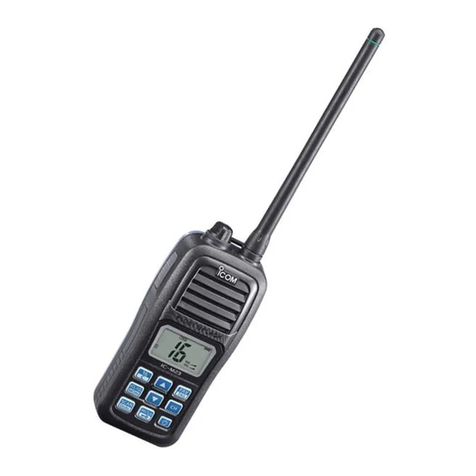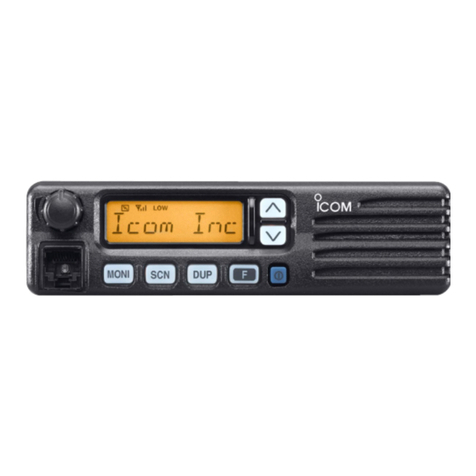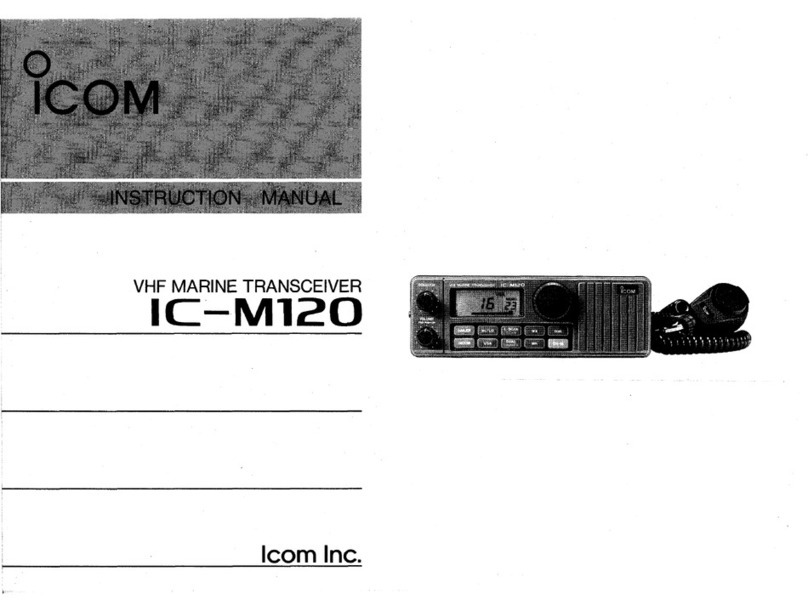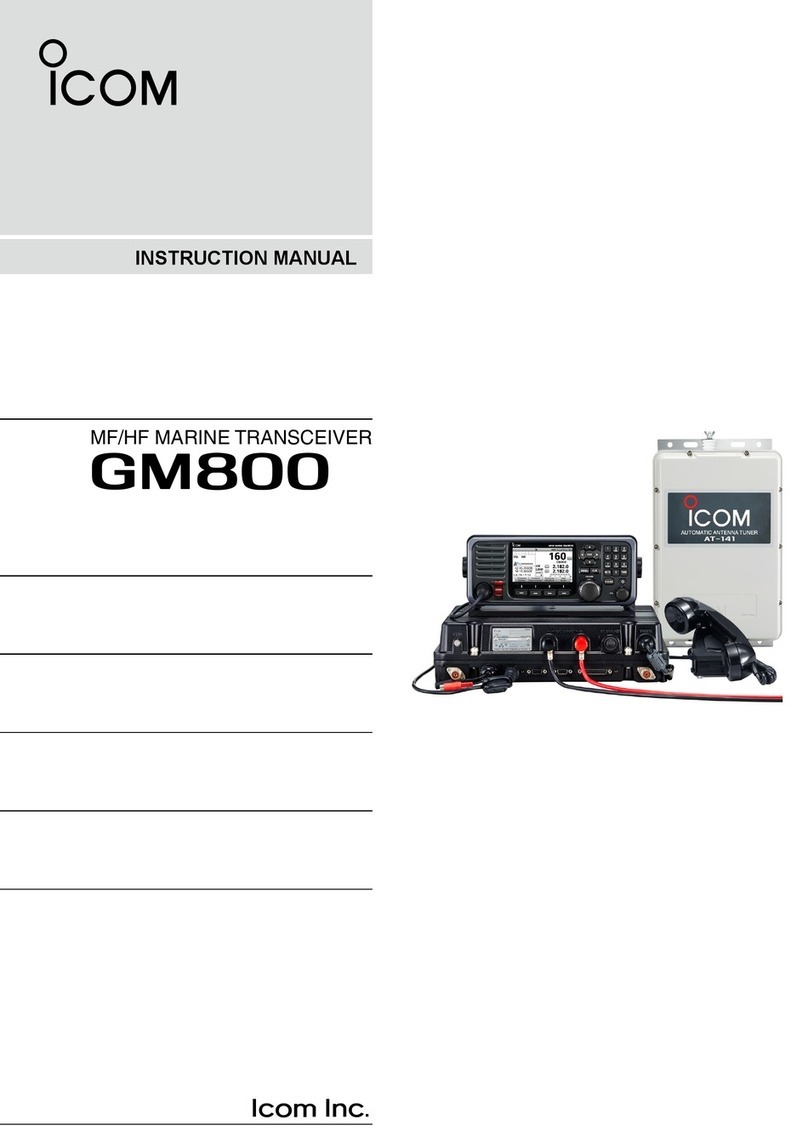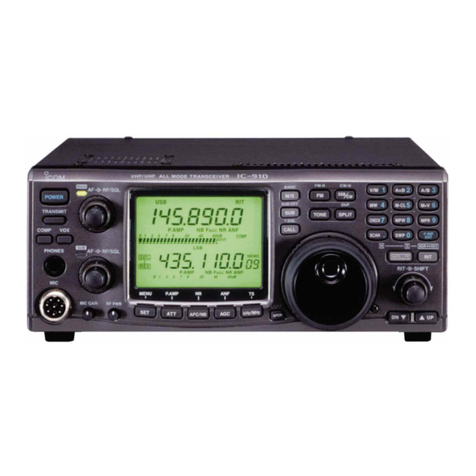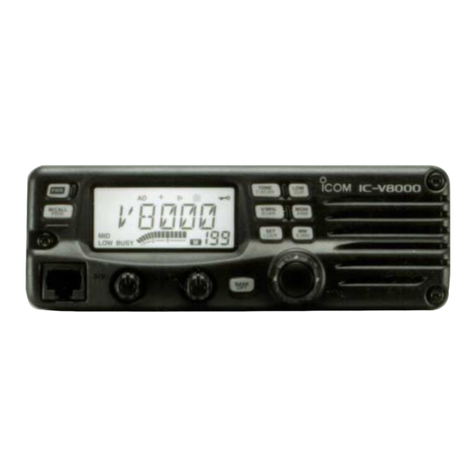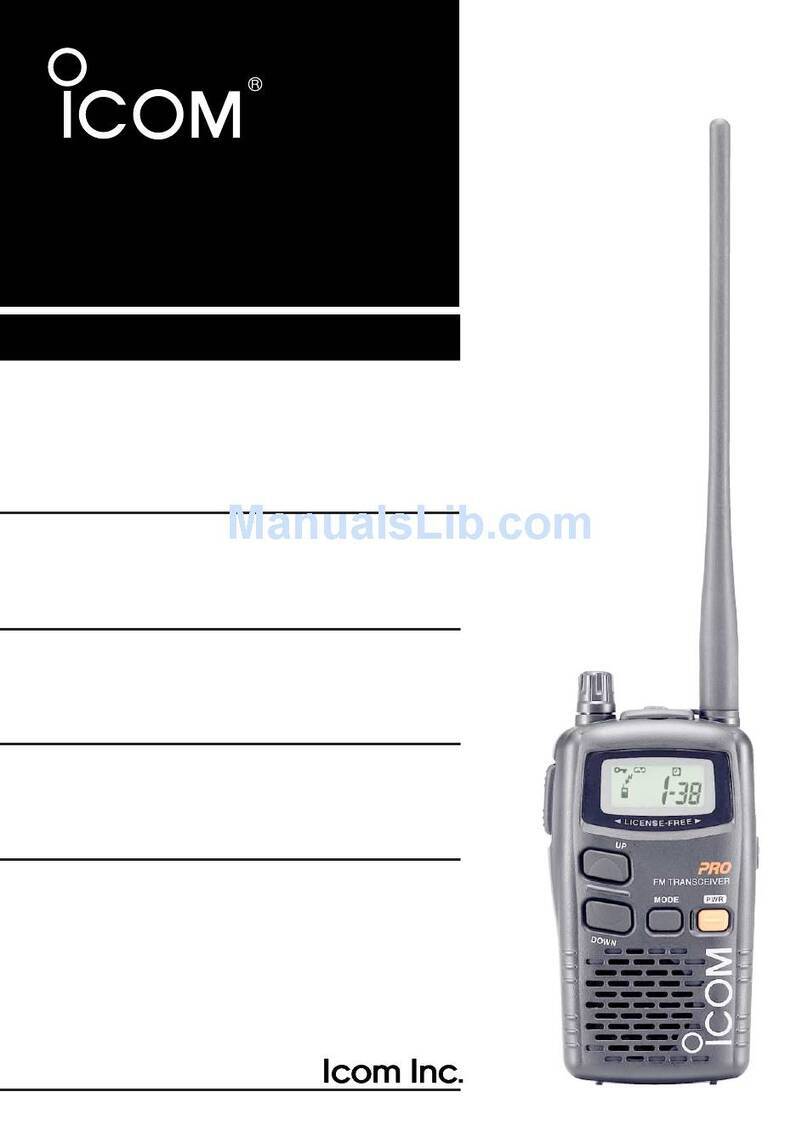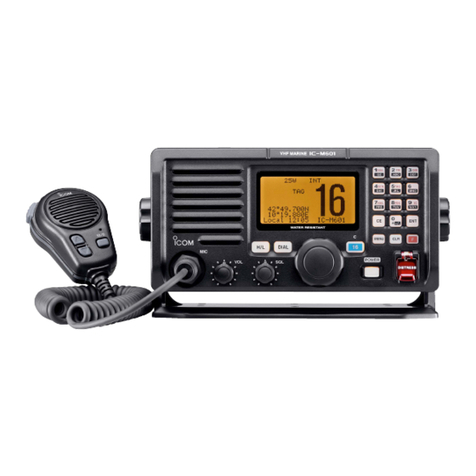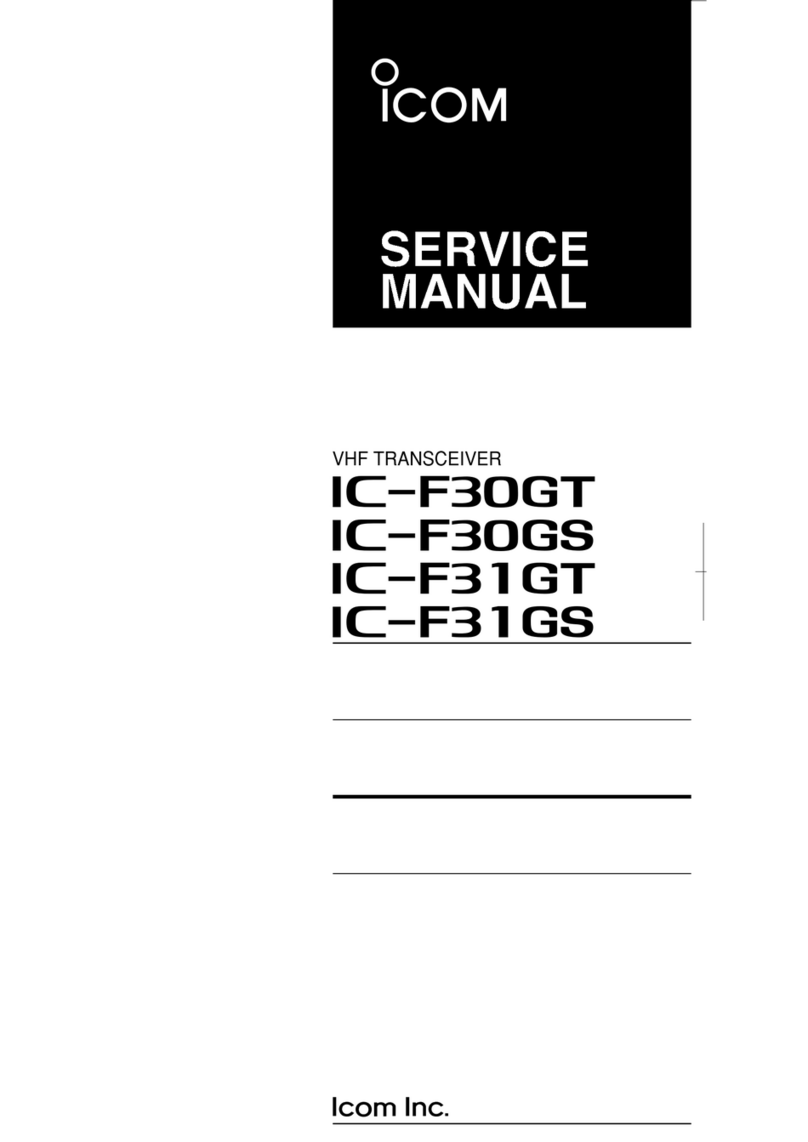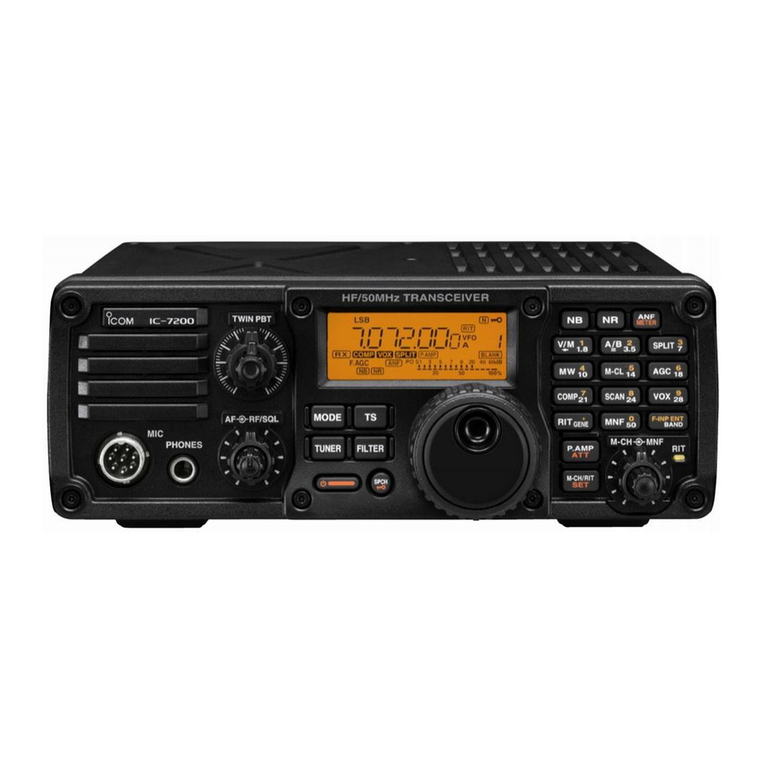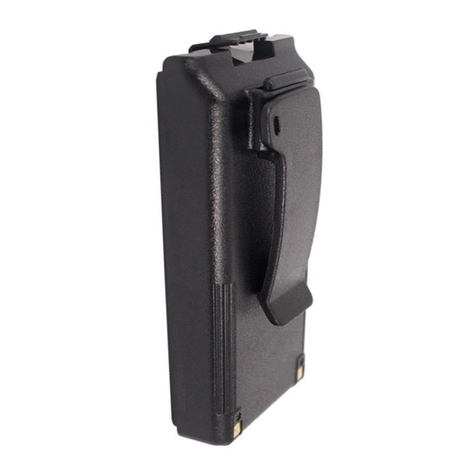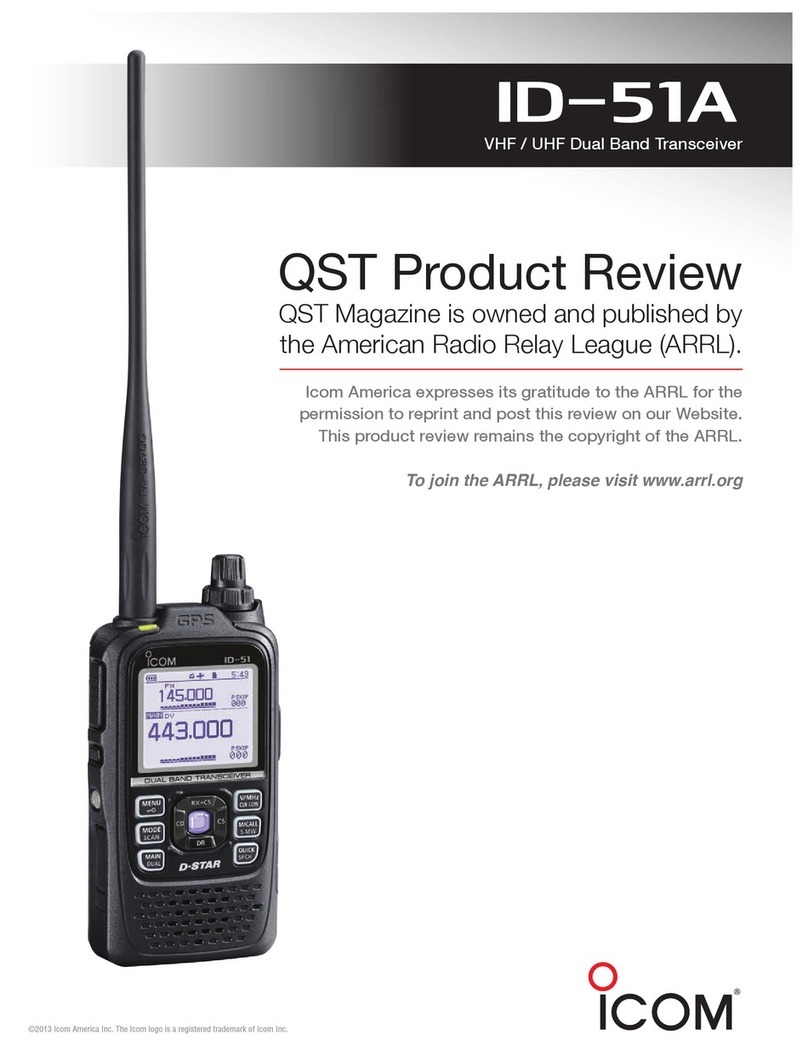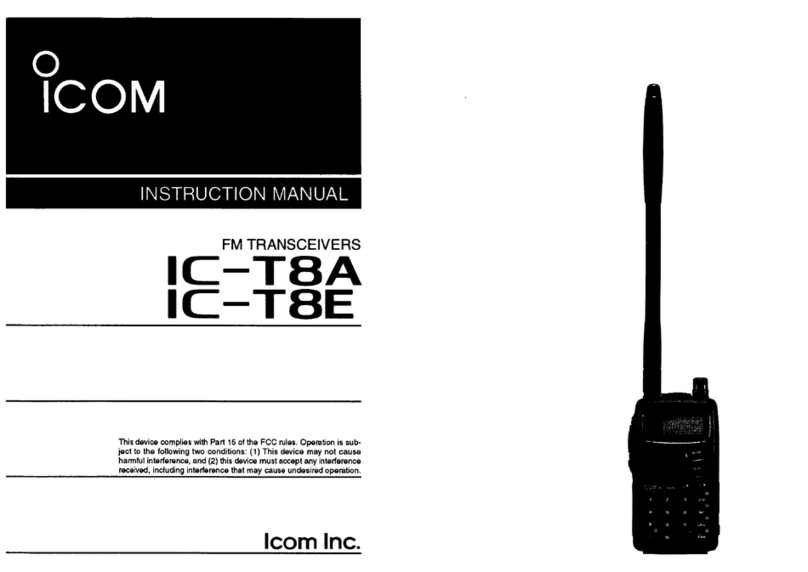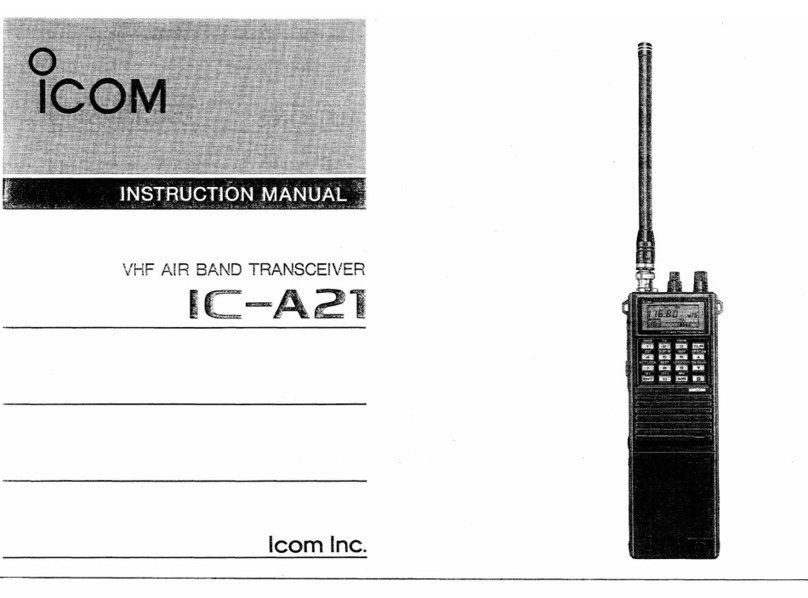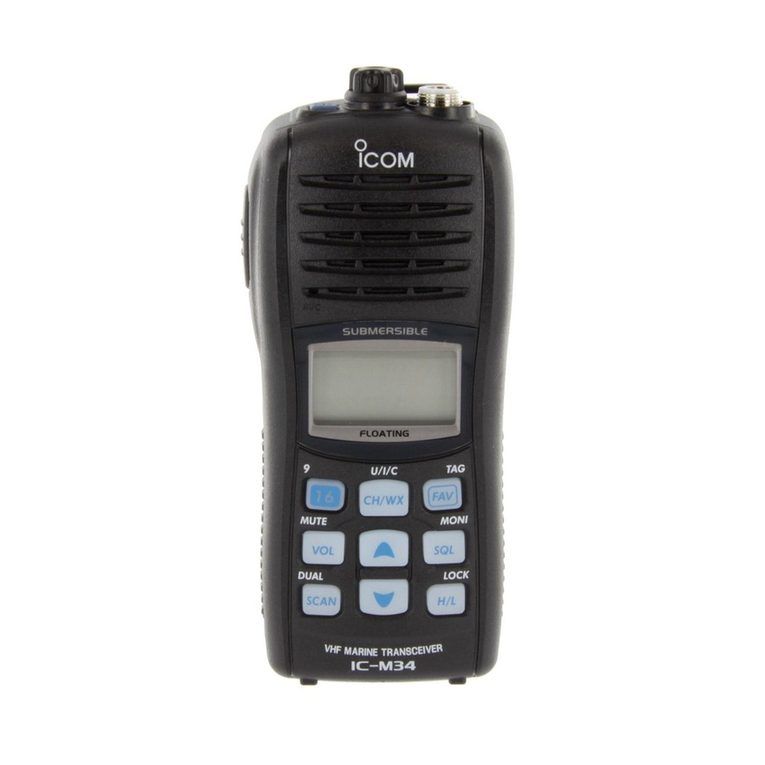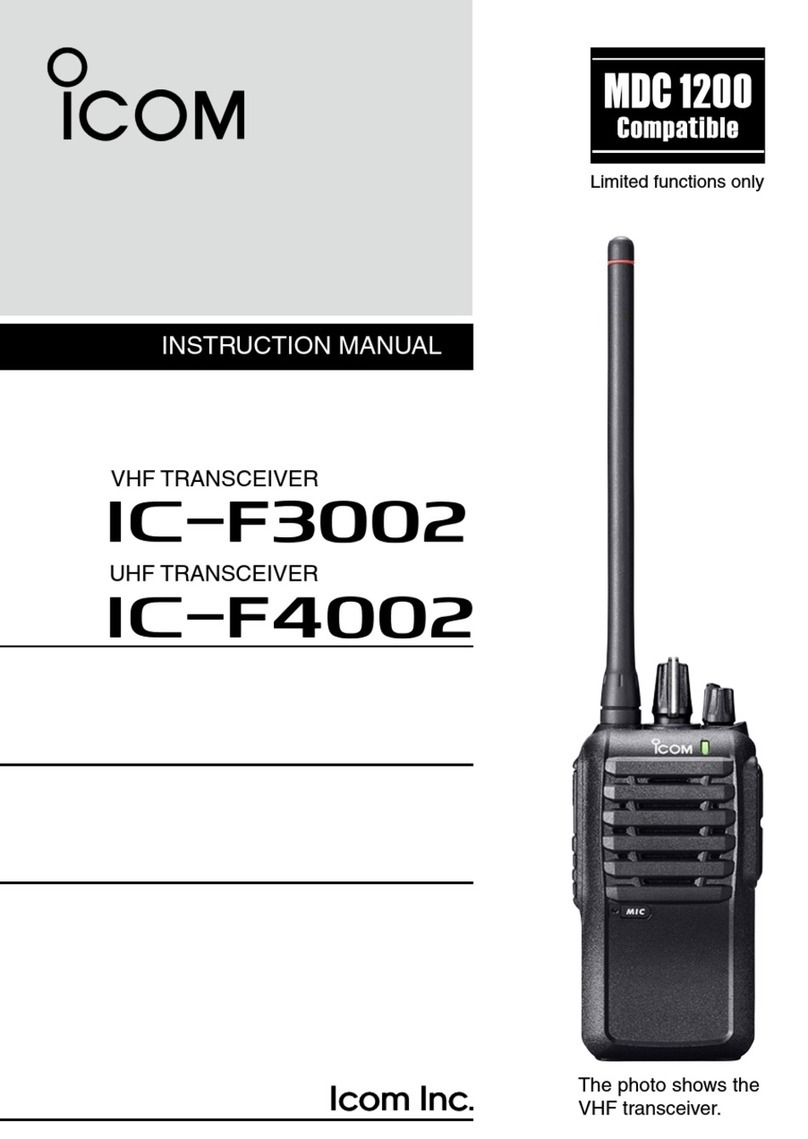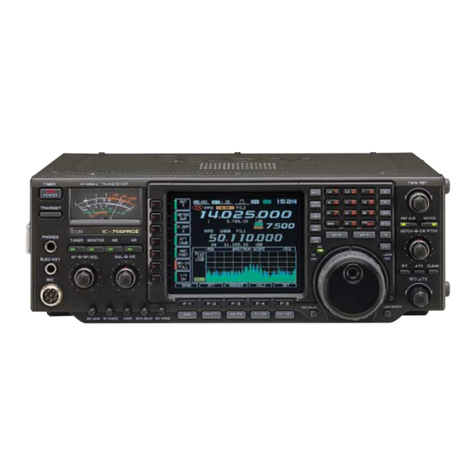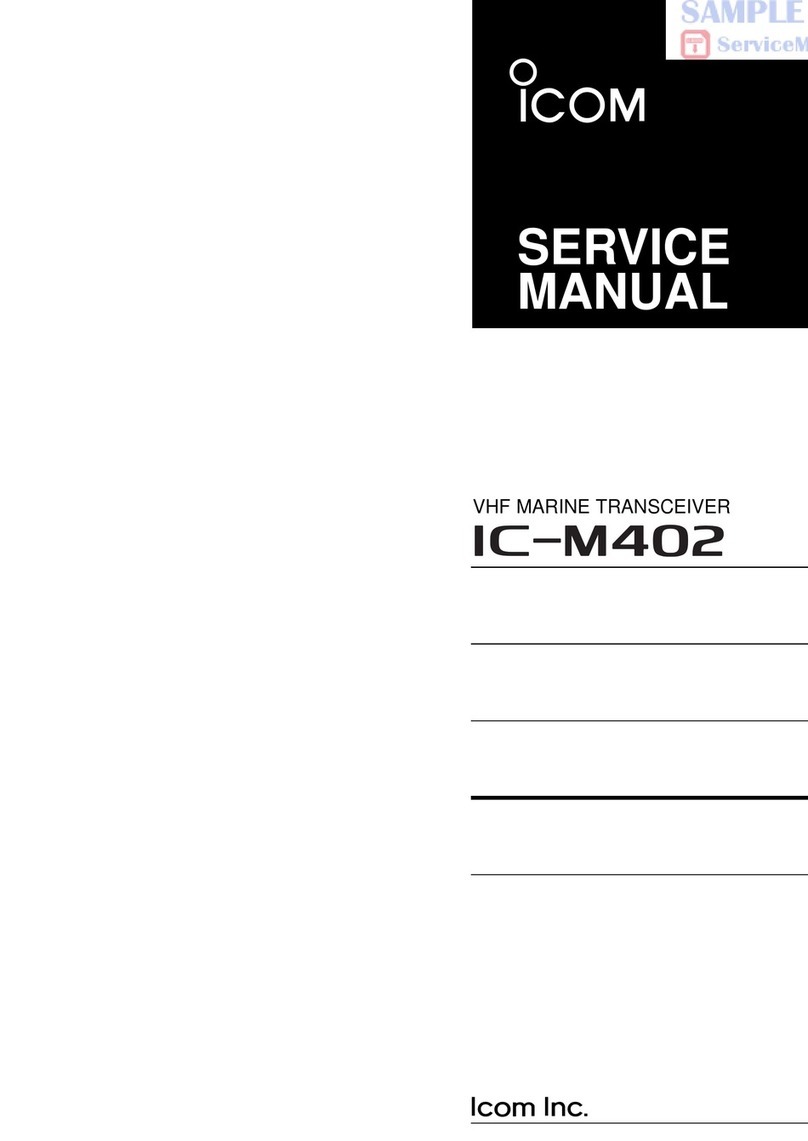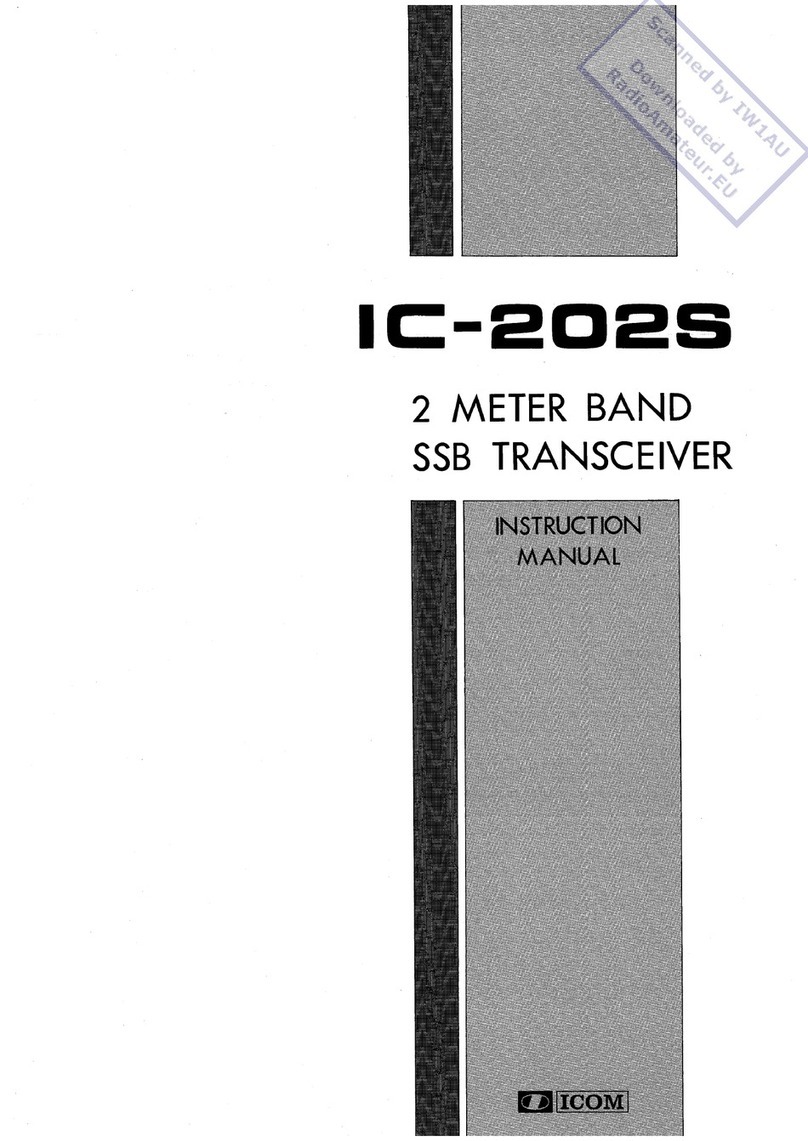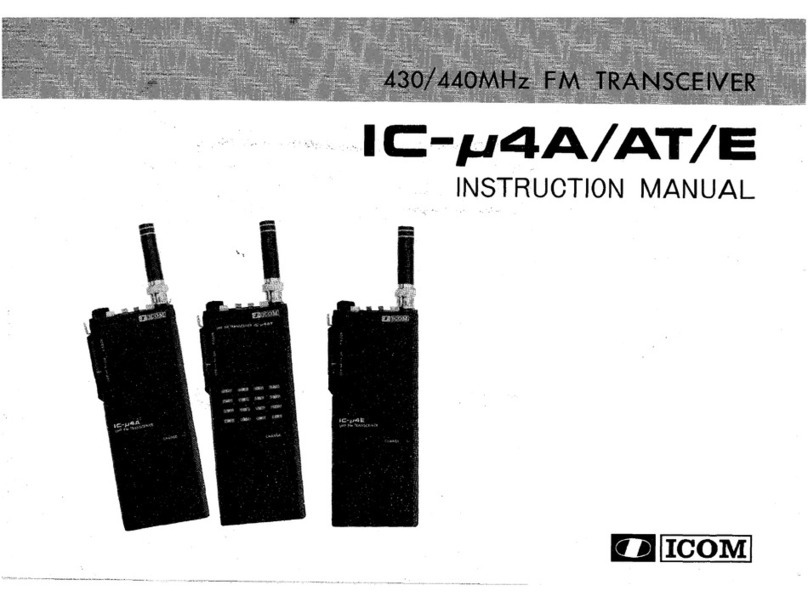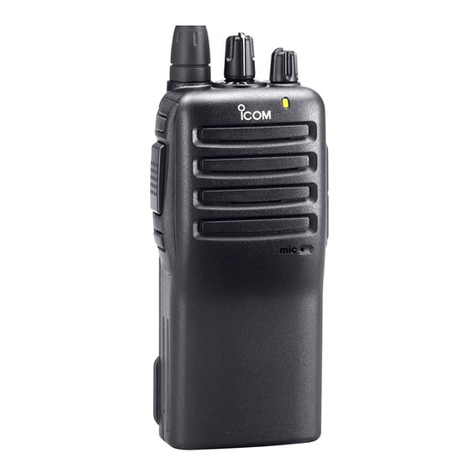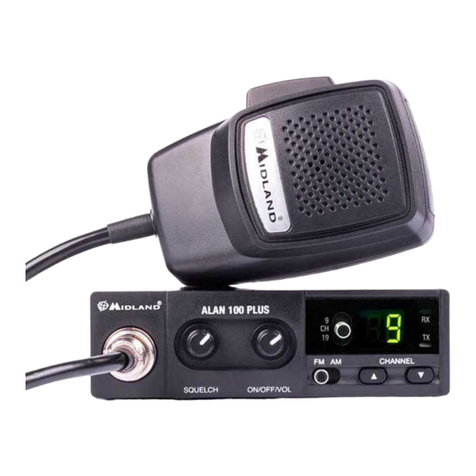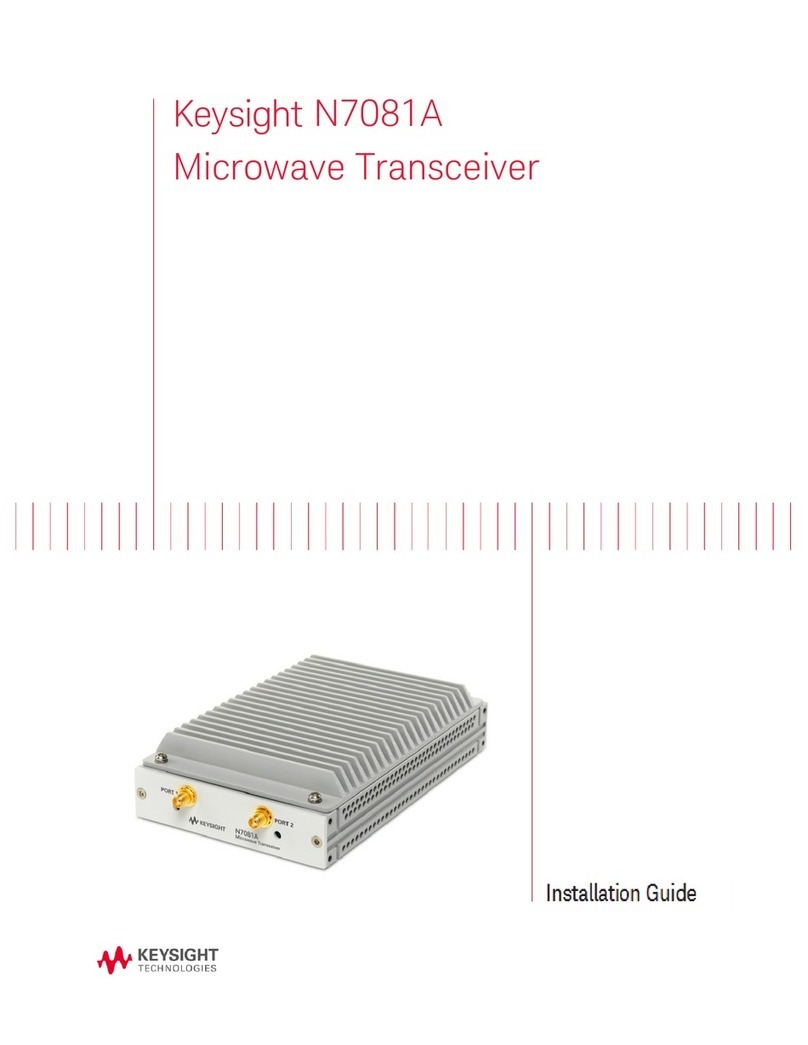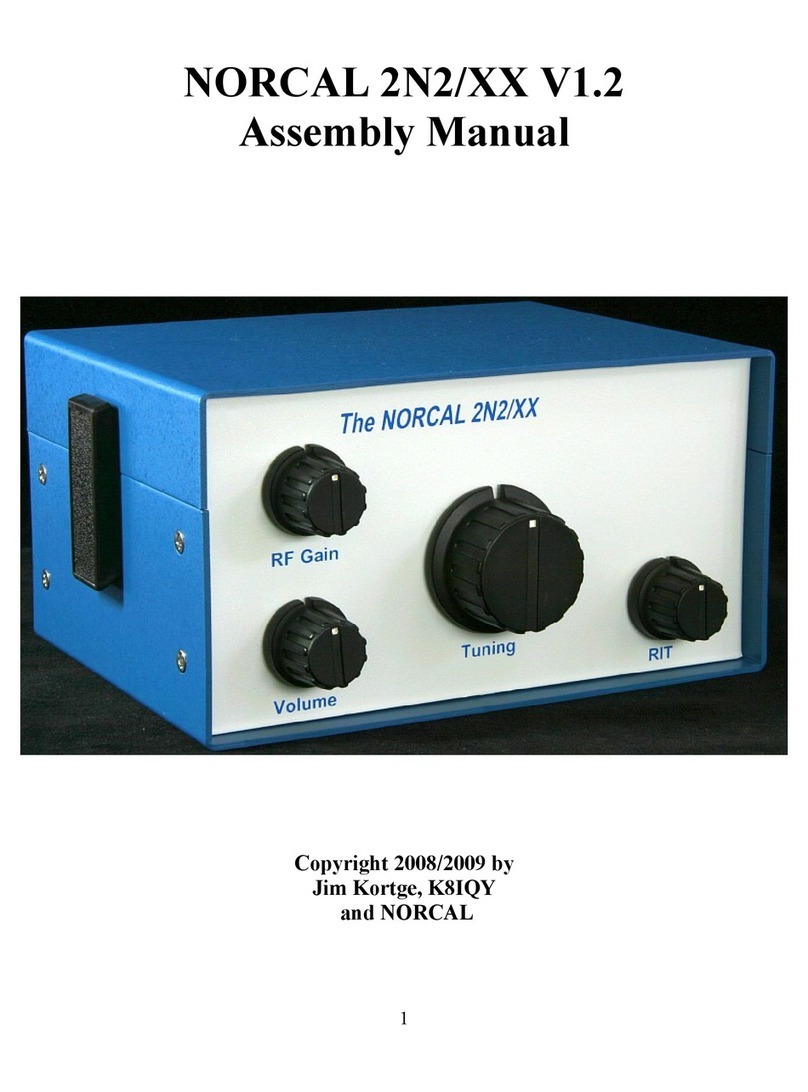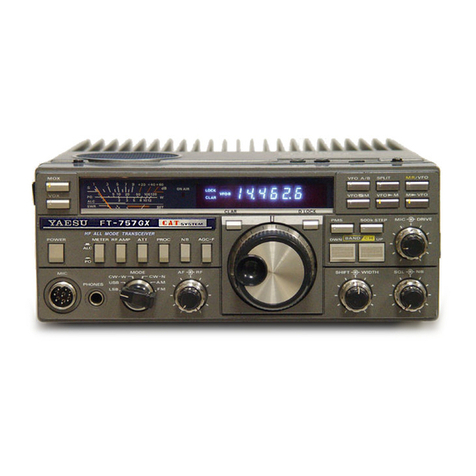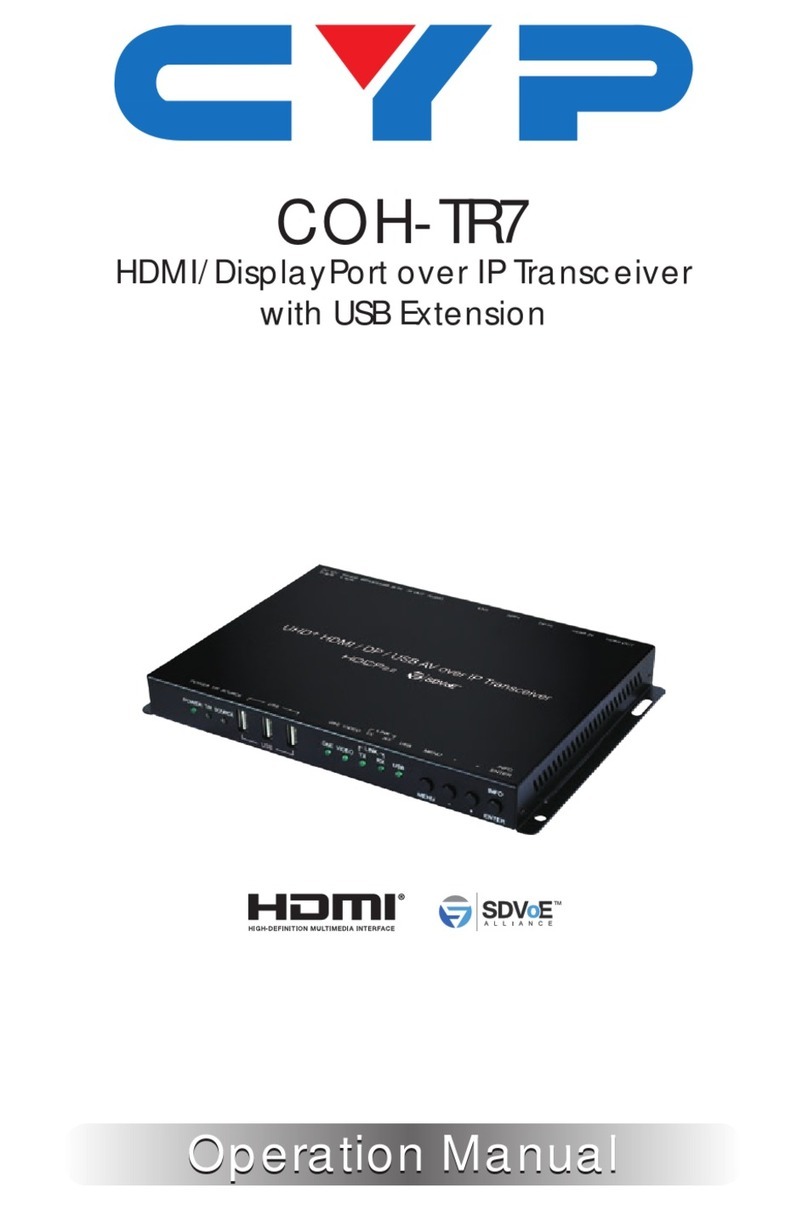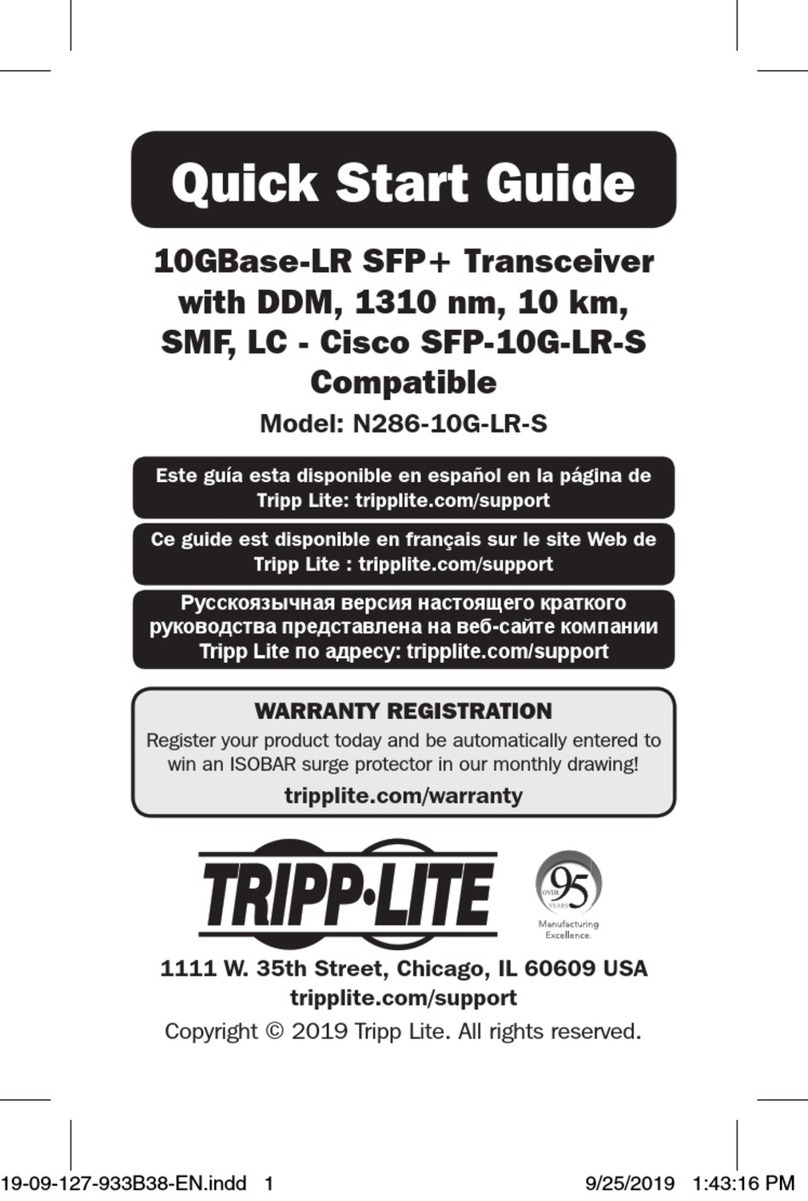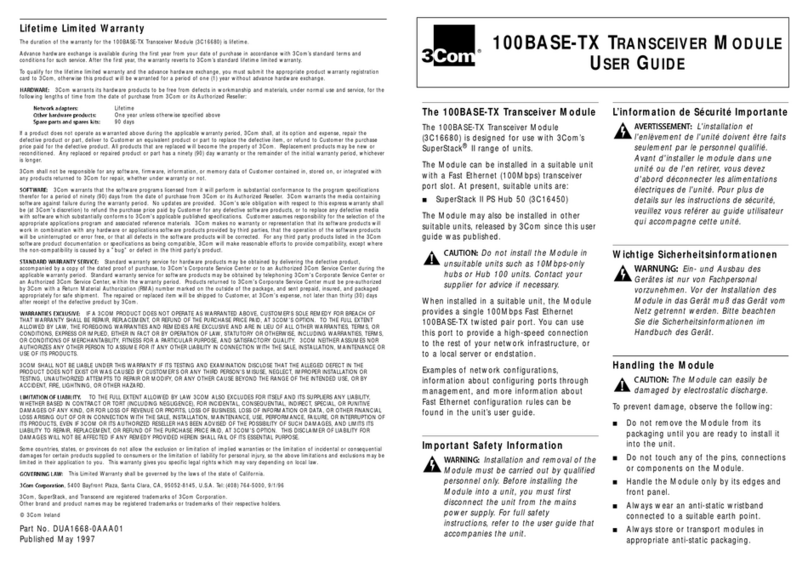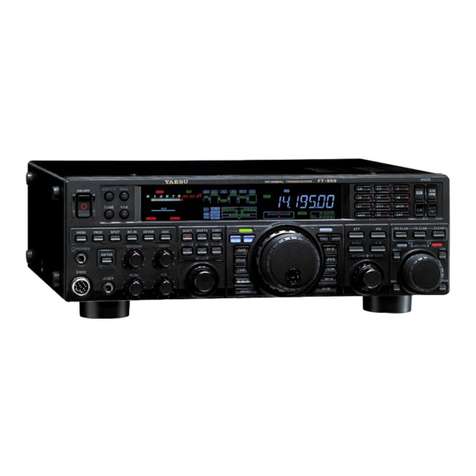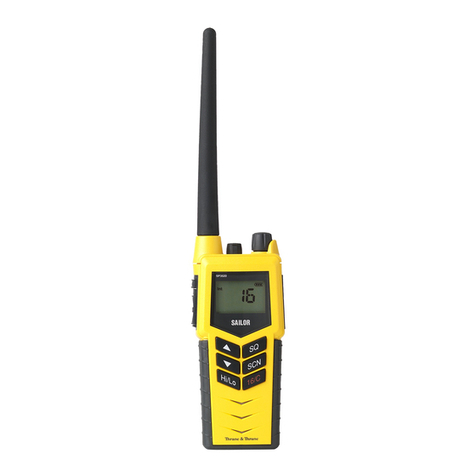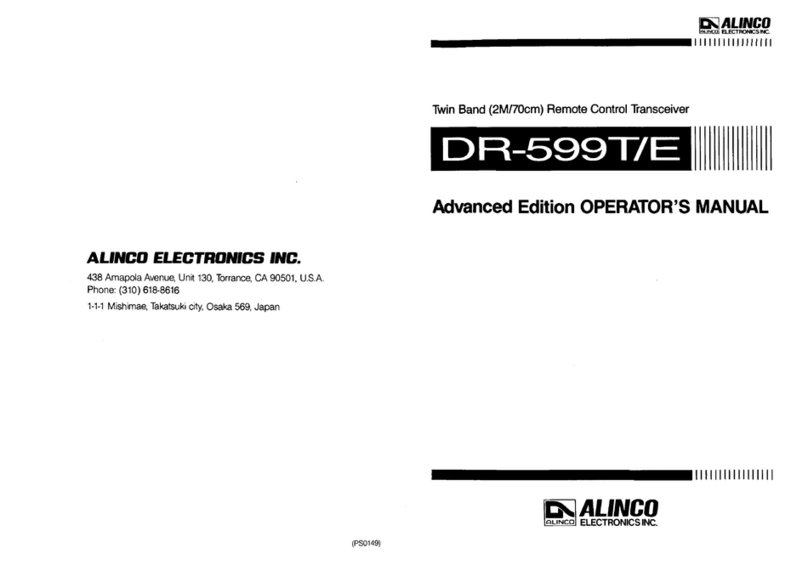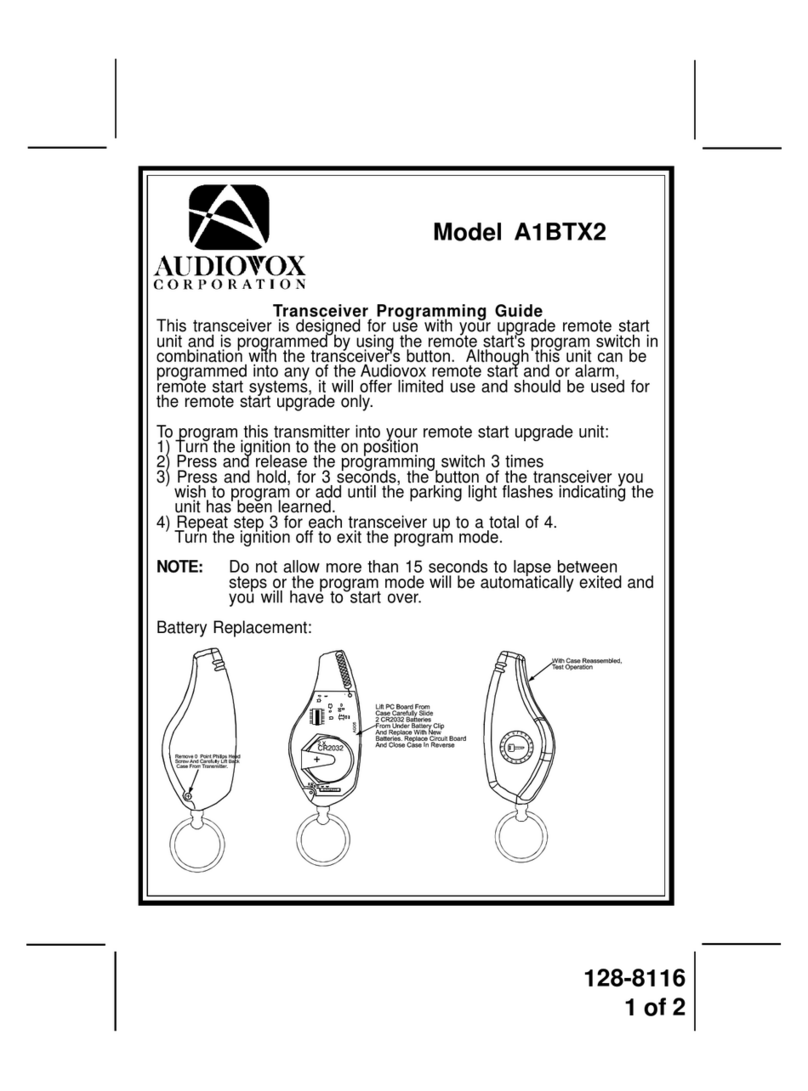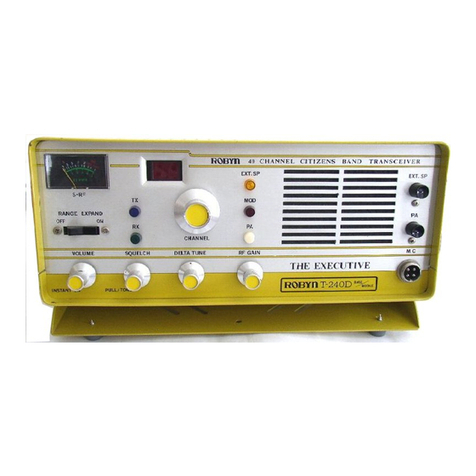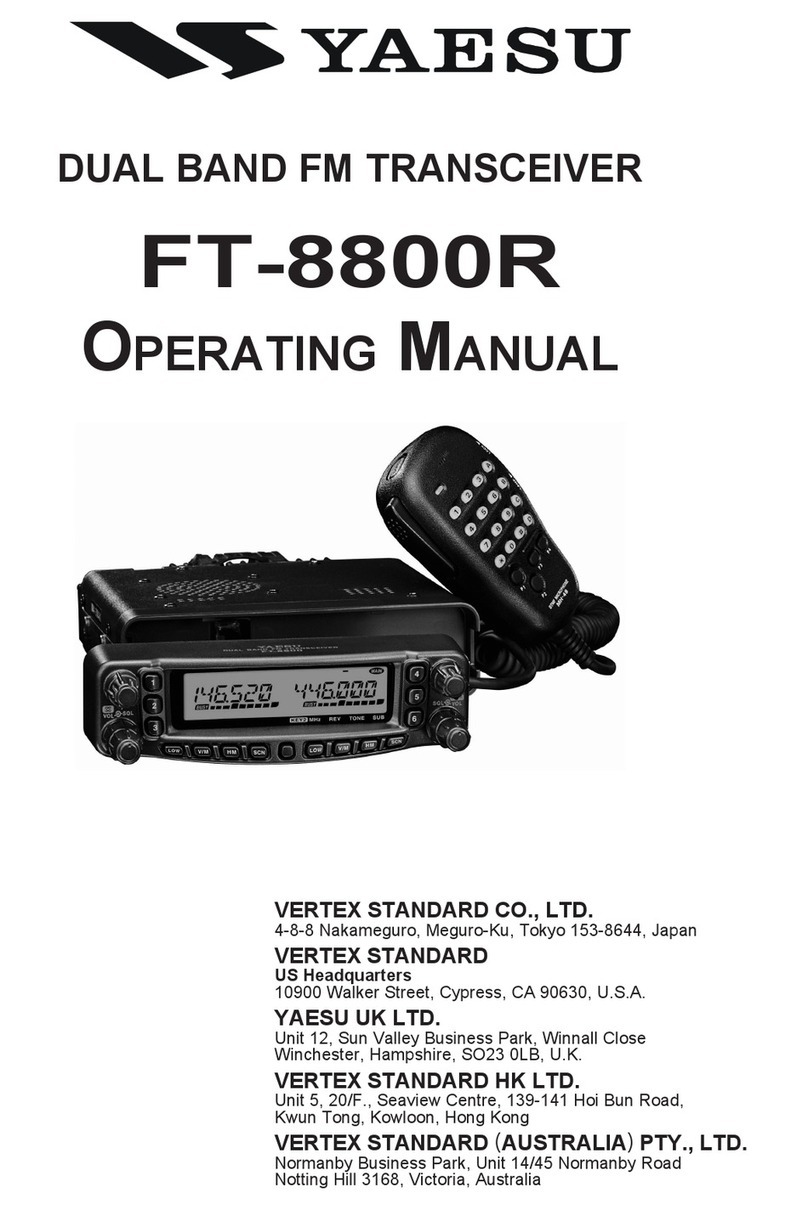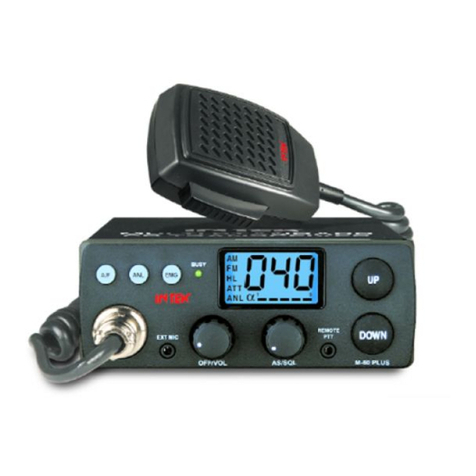Icom IC-F3200DEX User manual

OPERATING INSTRUCTIONS
iF3200DEX
series
5 SPEAKER MICROPHONE
4 dPMR™OPERATION
3 BASIC OPERATION
2 PANEL DESCRIPTION
1 ACCESSORIES
INTRODUCTION
VHF DIGITAL/ANALOG TRANSCEIVERS
iF4200DEX
series
UHF DIGITAL/ANALOG TRANSCEIVERS

i
INTRODUCTION
FOREWORD
Thank you for purchasing this Icom transceiver.
The IDAS™dPMR™system operation is built into your
transceiver.
IMPORTANT
FIRST, CAREFULLY READ INSTRUCTIONS
qPRECAUTIONS and wINSTRUCTIONS that are
provided with the transceiver.
SAVE THIS OPERATING GUIDE— This op-
erating guide contains additional important operating
instructions for the IC-F3201DEX, IC-F3202DEX or
IC-F3203DEX v h f digital/a n a l o g t r a n s c e i v e r s and
IC-F4201DEX, IC-F4202DEX or IC-F4203DEX u h f
digital/a n a l o g t r a n s c e i v e r s .
NOTE
To use in explosive atmospheres, read the leaflet
“SAFETY MANUAL” comes with the transceiver.
Icom, Icom Inc. and the Icom logo are registered trademarks
of Icom Incorporated (Japan) in Japan, the United States,
the United Kingdom, Germany, France, Spain, Russia and/
or other countries.
IDAS is trademark of Icom Incorporated (Japan).
dPMR and the dPMR logo are trademarks of the dPMR MoU
Association.
All other products or brands are registered trademarks or
trademarks of their respective holders.

1-1
Section 1ACCESSORIES
Supplied accessories..............................................................1-2
Accessory attachments ..........................................................1-3
Flexible antennaD......................................................................1-3
Battery packD............................................................................1-3
Belt clipD....................................................................................1-4
Connector coverD......................................................................1-4

1ACCESSORIES
1-2
Supplied accessories
The following accessories are supplied.
Battery pack*
Belt clip* Connector cover
(with screws)
Battery charger* Power adapter*
* Not supplied, or the shape is different, depending on the transceiver’s version.
Flexible antenna
(This illustration is for the VHF type.)

1ACCESSORIES
1-3
Accessory attachments
Flexible antennaD
Connect the supplied flexible antenna to the antenna
connector.
CAUTION:
• NEVER carry the transceiver by holding only the
antenna.
• DO NOT connect any antenna other than those
listed on the basic instructions.
• Transmitting without an antenna will damage the
transceiver.
Battery packD
To attach the battery pack:
Slide the battery pack on the back of the transceiver in
the direction of the arrow (q), then lock it with the battery
release button.
• Slide the battery pack until the battery release button makes
a ‘click’ sound.
To remove the battery pack:
Push the battery release button in the direction of the
arrow (w), as shown to the right. The battery pack is
then released, and you can remove it.
NEVER remove or attach the battery pack when the
transceiver is wet or soiled. This may result in water
or dust getting into the transceiver/battery pack and
may damage the transceiver.
NOTE: Keep the battery pack terminals clean. It’s a
good idea to occasionally clean them.
q
w
Battery release
button

1ACCESSORIES
1-4
Belt clipD
Before attaching or detaching the belt clip, remove the
battery pack if it is attached.
To attach the belt clip:
Slide the belt clip in the direction of the arrow until➥
the belt clip locks and makes a ‘click’ sound.
To detach the belt clip:
Lift the tab up (➥q), and slide the belt clip in the direc-
tion of the arrow (w).
Accessory attachments (Continued)
Connector coverD
To attach the connector cover:
Place the connector cover over the multi-connector.q
(q)
Tighten the screw. (ww)
To detach the connector cover:
Remove the screw using a Phillips screwdriver. (qe)
Detach the connector cover to connect optionalw
equipment. (r)
Belt clip
w
q
Ta b
r
e
q
w
CAUTION:
Attach the connector cover when the optional ac-
cessory is not used. Otherwise, the terminals of the
multi-connector may be shorted, and this could dam-
age the transceiver.

2PANEL DESCRIPTION
2-2
Microphone
Speaker
Front, top and side panels
qROTARY SELECTOR
Rotate to select the preprogrammed memory chan-
nels or scan lists, depending on the preprogram-
ming.
wVOLUME CONTROL [VOL]
Rotate to turn the power ON or OFF, and adjust the
audio level.
eSTATUS INDICATOR (pp. 2-3, 2-4)
Lights red while transmitting.➥
Lights green while receiving a signal, or when the➥
squelch is open.
Lights/blinks orange when the matched 2/5-tone➥
code is received, depending on the presetting.
rMULTI CONNECTOR
Connect optional accessory.
CAUTION:
Attach the connector cover
when the optional acces-
sory is not used. Otherwise,
the terminals of the multi-
connector may be shorted,
and this could damage the
transceiver.
tPTT SWITCH [PTT]
Hold down to transmit; release to receive.
yLOWER KEY [Lower]
uUPPER KEY [Upper]
Desired functions can be preset. (p. 2-5)
iEMERGENCY KEY [Emer]
Desired functions can be preset. (p. 2-5)
oANTENNA CONNECTOR
Connect the antenna.
wVOLUME
CONTROL
eSTATUS INDICATOR
yLOWER KEY
uUPPER KEY
qROTARY
SELECTOR
oANTENNA
CONNECTOR
rMULTI
CONNECTOR
tPTT SWITCH
Connector
cover
iEMERGENCY
KEY

2PANEL DESCRIPTION
2-3
Status indicator
• TX:
Lights Red while transmitting.
• RX busy:
On an analog channel, lights Green when in the
noise squelch opens.
On a digital or mixed channel, lights Green while de-
tecting a frame synchronization.
• Call LED:
Turns ON when receiving a matched 2/5-tone, or re-
ceiving a Status or SDM (Short Data Message) call.
• Call LED:
Blinks when receiving a matched 2/5-tone, or receiv-
ing a Status or SDM (Short Data Message) call.
• Call LED:
Blinks while waiting for a return signal.
• Success:
Blinks slowly when your call was successful.
• Call error:
Blinks slowly when your call failed, or was refused.
• Audible:
Blinks slowly after a return signal is received when in
the Audible mode*.
*Mute is released. (Received signal will be heard.)
• Fast, Slow or Voting scan:
Blinks when scanning for a channel to search for a
signal.
• Low Battery 1:
You should charge the battery soon. (blinks slowly)
• Low Battery 2:
You must charge the battery. (blinks fast)
• TX low Battery 1:
Low Battery was detected in the TX mode.
• TX low Battery 2:
Very Low Battery was detected
in the
TX mode.
R
G
O
O O
O O O
O O O
O G
O R
O
O
G G
G G
G G G G
R R
R R R R
The status indicator indicates the various parameters
of the transceiver as follows;
(Reference: R is Red, G is Green, O is Orange)

2PANEL DESCRIPTION
2-4
• Channel Error:
Blinks when a non-programmed channel is select-
ed.
• Power ON:
Blinks at transceiver startup.
• TX inhibit:
Blinks while in the TX inhibit mode such as when the
TOT or Lockout function is activated.
• Emergency:
Blinks when an Emergency call was received.
• Emergency Locator Ringer Siren:
Blinks while the Emergency locator, Ringer or Siren
is activated.
Status indicator (Continued)
R O O O
G O R G O R G O R G O R
G O R G O R G O R G O R
R O R O R O R O R O R O R O R O
R O GRO G

2PANEL DESCRIPTION
2-5
Programmable function keys
The programmable key functions can be assigned to
the [Upper], [Lower] and [Emer] programmable func-
tion keys.
LOWER KEY
UPPER KEY
EMERGENCY
KEY

2PANEL DESCRIPTION
2-6
Programmable function keys (Continued)
The following functions can be assigned to the [Upper],
[Lower] and [Emer] programmable function keys.
SCAN
Push to start and cancel scanning.
• When the scan started with the Power ON Scan or Auto
Scan function, push to pause the scan. The paused scan
resumes after the specified time period has passed.
PRIORITY A CHANNEL, PRIORITY B CHANNEL
Push to select the Priority A or Priority B channel.
PRIORITY A CHANNEL (REWRITE),
PRIORITY B CHANNEL (REWRITE)
Push to select the Priority A or Priority B channel.➥
Hold down [Prio A (Rewrite)] or [Prio B (Rewrite)]➥
for 1 second to assign the operating channel to the
Priority A or Priority B channel, respectively.
MEMORY CHANNELS 1, 2, 3, 4
Push to directly select memory channel 1, 2, 3 or 4, if
programmed.
LONE WORKER (p. 3-13)
Hold down for 1 second to turn ON the Lone Worker➥
function.
• When the Lone Worker function is turned ON, and no
operation is performed for the specified time period, the
Emergency function is automatically turned ON.
Push to turn OFF the Lone Worker function.➥
MONITOR, MONITOR (AUDIBLE)
Push to turn the CTCSS (DTCS) or 2/5-tone squelch➥
Mute ON or OFF.
• Only during LMR operation, push to open any squelch
functions, or deactivate any mute functions.
• Only during PMR operation, push to activate one or two
of the following functions on each channel.
- Hold down to unmute the channel (Audible mode).
- Push to mute the channel (Inaudible mode).
- Push to send a ‘reset code’ after the communication is
finished.
NOTE: The unmute condition may automatically
return to the mute condition, after a specified time
period.
Depending on the presetting, holding down this key➥
for 1 second cancels a scan.
LOCK
Hold down to electronically lock all programmable keys
except [Moni(Audi)], [Call] (including Call A and Call B),
[Emergency], [Surveillance] and [Lone Worker].
HIGH/LOW (p. 3-12)
Select the transmit output power level temporarily or
permanently, depending on the presetting.
TALK AROUND
Hold down for 1 second to turn ON the Talk Around➥
function.
• The Talk Around function equalizes the transmit frequen-
cy to the receive frequency for transceiver-to-transceiver
communication.
Push to turn OFF the Talk Around function.➥
DTMF AUTODIAL
Push to transmit a programmed DTMF code.
RE-DIAL
Push to transmit the last-transmitted DTMF code.
NOTE: TX memories are cleared after turning OFF
the transceiver.
WIDE/NARROW
Push to select the IF bandwidth between Wide, Mid*
or Narrow.
*Depending on the presetting, the Mid channel width may not
be selectable.
CALL, CALL A, CALL B
Push to transmit a 2/5-tone code.
• Tone call transmission may be necessary before you call
another station, depending on your signalling system.
• [Call A] and/or [Call B] keys may be selectable when your
system employs selective ‘Individual/Group’ calls.
EMERGENCY
Hold down for specified time period to transmit an
emergency call.
• The emergency call transmits with beeps, and the status
indicator lights red.
• The transceiver can transmit an emergency call without the
beep sounding and the status indicator lighting.
• If you want to cancel the emergency call, hold down the key
again before transmitting the call.
• The emergency call is transmitted one time only, or repeat-
edly until receiving an acknowledgement signal, or until the
power is turned OFF.
When a matched 5-tone code signal is received, the emer-
gency function can be cancelled, depending on the preset-
ting. (PMR operation only)

2PANEL DESCRIPTION
2-7
Programmable function keys (Continued)
SURVEILLANCE
Hold down for 1 second to turn ON the Surveillance➥
function.
• When this function is turned ON, the beep is not heard
and the status indicator does not light when a signal is
received, or a key is pushed.
Push to turn OFF the Surveillance function.➥
SIREN
Hold down for 1 second to emit a siren sound.
This function can be used for situations other than an
emergency alert, such as a security alarm for exam-
ple.
The transceiver emits the siren sound until the power
is turned OFF.
SCRAMBLER
Hold down for 1 second to turn ON the Voice Scram-➥
bler function while operating in the digital mode.
Push to turn OFF the Voice Scrambler function.➥
ANNOUNCE
Push to turn the Channel Announce function ON or
OFF.
• When this function is turned ON, the transceiver announces
the position of [ROTARY SELECTOR] between 1 and 16
when rotating [ROTARY SELECTOR] to a desired number.

3-1
Section 3BASIC OPERATION
Turning ON the power .............................................................3-2
Selecting a channel.................................................................3-3
Selecting a channelD.................................................................3-3
Voting OperationD......................................................................3-3
Priority A channel selectionD.....................................................3-3
Call procedure .........................................................................3-4
Receiving and transmitting ....................................................3-5
Transmitting notesD...................................................................3-5
DTMF transmissionD.................................................................3-6
Receiving a Stun, Kill and Revive commandD...........................3-6
Setting the Beep function .......................................................3-7
Setting the beep level..............................................................3-8
Setting the ringer level............................................................3-9
Setting the microphone gain ..................................................3-10
Setting the squelch level ........................................................3-11
Output power level selection..................................................3-12
Emergency Call........................................................................3-13
Lone Worker Emergency CallD..................................................3-13
Man Down Emergency CallD.....................................................3-13

3BASIC OPERATION
3-2
Turning ON the power
Prior to using the battery pack for the first time, or after
not using it for a long time, you must fully charge the
pack for optimum battery life and operation. See BASIC
INSTRUCTIONS that are provided with the transceiver
for details.
Rotate [VOL] to turn ON the power.➥
[VOL]

3BASIC OPERATION
3-3
Selecting a channel
Selecting a channelD
To select the desired operating channel:
Rotate [ROTARY SELECTOR].➥
Push one of the memory channel keys, [MR-CH 1]➥
to [MR-CH 4].
Push [Prio A], [Prio B], [Prio A (Rewrite)] or [Prio B➥
(Rewrite)].
AUTOMATIC SCAN TYPE:
Selecting a channel is not necessary. When turning ON
the power, the transceiver automatically starts scan-
ning. Scanning stops when a signal is detected.
Voting OperationD
The transceiver automatically starts scanning when a
zone, specified for the voting operation, is selected.
The voting scan detects the signal of the repeater and
automatically selects the strongest station.
Priority A channel selectionD
When one of the following operations is performed, the
transceiver automatically selects the Priority A chan-
nel.
• Turning ON the power
The Priority A channel is selected each time the trans-
ceiver power is turned ON.
• Auto reset
The Priority A channel is selected when the Auto Reset
timer ends.

3BASIC OPERATION
3-4
Call procedure
When your system employs tone signalling (excluding
CTCSS and DTCS), the tone call procedure may be
necessary prior to voice transmission. The tone signal-
ling that is employed in the transceiver may be a selec-
tive calling system, which allows you to call only spe-
cific station(s), and prevents unwanted stations from
contacting you.
Select a desired TX code channel or 2/5-tone code,q
according to your System Operator’s instructions.
• This may not be necessary, depending on the program-
ming.
Push [Call] (assigned to [Upper], [Lower] or [Emer]).w
(p. 2-6)
After transmitting a 2/5-tone code, the remainder ofe
your communication can be carried out normally.
Selective calling Non-selective calling

3BASIC OPERATION
3-5
Receiving and transmitting
Receiving:
Rotate [VOL] to turn ON the power.q
Select a channel.w
Rotate [ROTARY SELECTOR].➥
Push one of the memory channel keys, [MR-CH 1]➥
to [MR-CH 4].
When receiving a call, adjust the audio output to ae
comfortable listening level.
NOTE: When a matched RX code signal is received,
the transceiver automatically transmits its micro-
phone audio for a specified time period, depending
on the presetting.
Transmitting:
CAUTION: Transmitting without an antenna will dam-
age the transceiver. See page 1-3 for antenna at-
tachment.
Wait for the channel to become clear to avoid interfer-
ence.
While holding down [PTT], speak into the micro-q
phone at a normal voice level.
Release [PTT] to receive.w
NOTE: To maximize the readability of your signal:
1. Pause briefly after pushing [PTT].
2.
Hold the microphone 5 to 10 cm (2 to 4 inches) from
your mouth, then speak at a normal voice level.
Transmitting notesD
• Transmit inhibit function
The transceiver has several inhibit functions, which re-
strict transmission under the following conditions:
- The channel is muted. (PMR operation only)
- The channel is busy.
- A signal with an unmatched (or matched) CTCSS (or
DTCS) tone is received.
- The selected channel is a ‘receive only’ channel.
• Time-out timer
After continuously transmitting longer than the prepro-
grammed time period, the time-out timer activates, and
stops further transmitting.
• Penalty timer
Once the time-out timer activates, transmitting is further
inhibited for a time period determined by the penalty
timer.
• PTTID call
The transceiver automatically sends the ID code (5-
tone, DTMF or BIIS operations) when [PTT] is pushed
(beginning of the transmission) and/or released (end of
transmission), depending on the presetting.

3BASIC OPERATION
3-6
Receiving and transmitting (Continued)
DTMF transmissionD
If the transceiver has [DTMF Autodial] assigned to it,
the automatic DTMF transmission function is usable.
Push [DTMF Autodial] to transmit the DTMF code.➥
The dispatcher can send a signal that will stun, kill or
revive your transceiver.
When the Stun command is received, a beep sounds*,
and the transceiver becomes unusable. Receiving a
Revive command is necessary to operate the trans-
ceiver again in this case.
When the Kill command is received, a beep sounds*,
and the transceiver becomes unusable. Cloning the
transceiver is necessary to operate the transceiver
again in this case.
* Depending on the presetting.
Receiving a Stun, Kill and Revive commandD

3BASIC OPERATION
3-7
Setting the Beep function
The Beep function can be turned ON or OFF. When it is
OFF, the channel announcement is also turned OFF.
NOTE: You should turn ON the Beep function when
you set the microphone gain or the squelch level to
check the current level setting with the beep sound-
ing. (pp. 3-10, 3-11)
Rotate [VOL] to turn OFF the transceiver power.q
Set [ROTARY SELECTOR] to any channel otherw
than Channel 16.
While holding down [Lower], rotate [VOL] to turn ONe
the power to enter the Beep level adjustment mode.
Push [Lower] to turn the Beep function ON or OFF.r
• When a beep sounds after pushing [Lower], the Beep
function is ON. When no beep sounds after pushing
[Lower], the Beep function is OFF.
• If desired, push [Upper] to adjust the Beep level. See
page 3-8 for details.
Rotate [VOL] to turn OFF the power to exit the Beept
level adjustment mode.
NOTE: This operation may not be available, depend-
ing on the presetting.
[ROTARY SELECTOR]
[VOL]
[Lower]
[Upper]
This manual suits for next models
1
Table of contents
Other Icom Transceiver manuals

